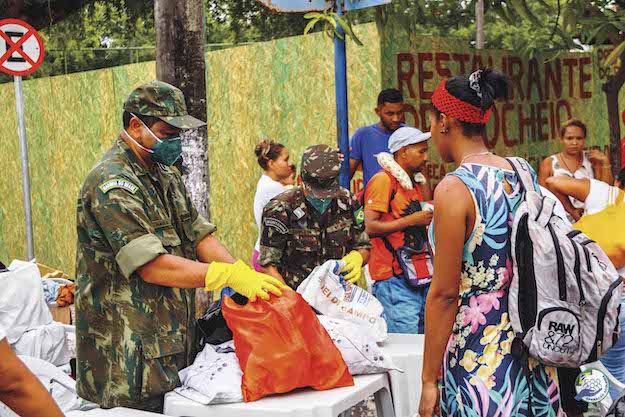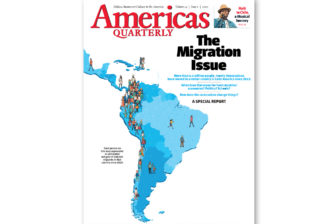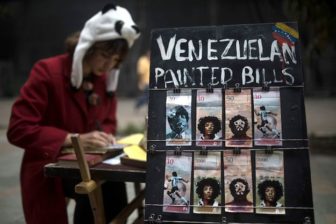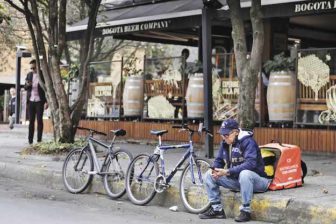This article is adapted from AQ’s special report on migration
The closure of borders this year by governments across Latin America in response to the coronavirus paused, and threatens to reverse, several years of largely receptive immigration policy. The exodus of Venezuelans as well as Nicaraguans and Central Americans from their countries has been met with varying levels of welcome. Here’s how national and local governments have set about integrating these new arrivals.
Argentina | Brazil | Chile | Colombia
Costa Rica | Ecuador | Mexico | Panama | Peru
Argentina
Argentina is one of the few countries that allows Venezuelans to enter without a passport. Even though Venezuela was suspended from the Mercosur trade bloc in 2017, Venezuelans can receive temporary residence in Argentina with their national ID cards. After two years in the country, Venezuelans are then eligible for permanent residence.
In Buenos Aires, where migrants comprise 15% of the population, the city organizes a series of festivals throughout the year, each celebrating a different country or region and the cultural and economic contributions of migrants from that place. The city also published Hola, Soy Migrante, a comprehensive welcome guide for new arrivals providing an introduction to the city’s culture and 13 chapters of useful information on how to access health care, migration services, employment and other services. The guide debuted to some criticism from representatives of street merchants, who said the inclusive posturing doesn’t line up with the city’s policies. There have been protests decrying police crackdowns of Senegalese migrants working as street vendors.
Brazil
In 2018, then-President Michel Temer tasked the army to lead Operação Acolhida (Operation Welcome), an effort in partnership with the U.N. refugee agency to assist Venezuelan arrivals. The army’s efforts include building and renovating shelters used to house Venezuelans in Brazil’s northwestern state of Roraima, on the border with Venezuela. To address the concentration of migrants in Roraima — specifically in the border town of Pacaraima and state capital Boa Vista— Operation Welcome voluntarily relocated some 33,000 Venezuelans to more accommodating cities between April 2018 and February 2020. The government, which connects relocated migrants with jobs, family members and other resources, allocated around $40 million to Operation Welcome in 2019 and an additional $65 million in 2020 for 11 emergency camps in Boa Vista and Pacaraima.
In São Paulo, several public-sector agencies have partnered with the U.N. refugee agency to better absorb newcomers, including the Municipal Secretariat of Assistance and Social Development, which in 2017 created a program that connects city residents, including migrants, to new jobs. The Municipal Council for Immigrants has also worked with the U.N. to offer migrants and refugees opportunities to learn about and get involved in public policies affecting them. The state of São Paulo’s Center for Immigrant Citizenship and Integration, meanwhile, offers resources for learning Portuguese, finding a job, and navigating the legal and migration systems.
Chile
Chile’s migrant population has tripled in the past three years, with large flows of people coming from Haiti and Venezuela. The government responded to the second group of migrants by creating a Democratic Responsibility Visa in 2019. The visa allows Venezuelans to stay in the country for a year, but requires migrants to submit various documents and a $30 fee at a Chilean consulate before arriving. At the same time, the government announced it would offer up to 10,000 family reunification visas offering temporary residence to Haitians, who make up the third largest foreign population in Chile after Venezuelans and Peruvians. The visa is good for one year and is renewable one time.
At the federal level, Chile’s Department of Migration and Foreigners — part of the Interior and Public Security Ministry — has a program that supports the work done by individual municipalities in the areas of migrant integration and intercultural exchange. Participating municipalities receive a Sello Migrante (Migrant Seal), a certification that recognizes the city’s existing efforts to welcome migrants and also commits the national government to collaborate with the city in future efforts. The municipality of Estación Central in Santiago is one example of a municipality with the Migrant Seal. To respond to its large Haitian population, the municipality created its own migration office. Estación Central also takes part in Escuela Somos Todos, a national program run by the interior ministry to get students into school regardless of their migration status.
The national migration department has also created the Compromiso Migrante (Migrant Commitment), a program similar to the Migrant Seal that incentivizes private companies and unions to take a non-discriminatory and inclusive approach to hiring and management. The recognition connects awardees with support from agencies like the International Labor Office and International Organization for Migration.
Colombia
Before the coronavirus spurred President Iván Duque to close Colombia’s border with Venezuela, some 2,000 Venezuelans were arriving daily. In recent years Colombia has taken a generous approach to migrants. “Our national policy is to try to be flexible,” Christian Krüger Sarmiento, then the director of Migración Colombia, said in 2019. Such efforts include Colombia’s internationally lauded Special Stay Permit, known as the PEP, a two-year permit first launched in 2017 that has given hundreds of thousands of Venezuelans regular migration status and, in turn, greater access to services like health care, banking, education and employment.
Seeing Venezuelan migration as inevitable, Colombia has allowed Venezuelans to enter the country with expired passports, opened its schools to migrant children, and given citizenship to babies born to Venezuelan mothers.
Home to one in five of the 1.8 million Venezuelan migrants in Colombia, Bogotá has embarked on what it calls its Migrant Assistance Route, a strategy to coordinate city services to help migrants. Bogotá, which the mayor’s office proudly calls “a city of open doors,” has spent more than $59 million attending to migrants. In 2018, the city’s Social Integration Office opened the first Integral Migrant Attention Center, which has helped meet the employment, psychological and logistical needs of more than 4,500 newcomers. The office also works with a special outpost at Bogotá’s main bus terminal to connect arrivals with services. The government estimates that some 3,500 children have passed through city centers opened for child and adolescent migrants. Bogotá’s mayor’s office has partnered with different organizations for several campaigns against xenophobia, including one that invites Venezuelan migrants to attend soccer games for free.
Barranquilla, which ranks third in Colombia by migrant population, is in the process of launching social impact bonds to boost migrant employment. The bonds are a form of public-private partnership that Colombia has used on a national level and in the city of Cali. They allow private entities to invest in projects that have a social good, and are repaid only if the project achieves the intended results. In Barranquilla’s case, social bonds are funding efforts to train and place city residents in jobs — 20% of which are reserved for migrants.
“What we want to do is include migrants within our strategies,” said Mariam Ajami Peralta of the Mario Santo Domingo Foundation, one of the partners in the initiative. “We’ve found that making services exclusive to one group creates more divisions.”
In Medellín, the city’s crisis assistance hotline has been a particularly useful tool for Venezuelans. Between 2017 and 2019, the hotline connected nearly 8,000 Venezuelans with resources like housing, transportation and medical help, as well as mental health assistance.
Costa Rica
In 2019, Costa Rica co-sponsored the first World Forum on Refugees in Geneva, where President Carlos Alvarado Quesada asked for international support in the country’s efforts to absorb a large influx of migrants. Fed by political crises in Nicaragua and Venezuela, Costa Rica’s migrant population last year was the region’s largest with respect to its population, according to Alvarado, at 10.5%.
Costa Rica has opened its public elementary and secondary schools to children from across the border in Nicaragua, who numbered some 32,000 in 2019 and represent one in every 40 students.
Ecuador
Ecuador’s 2008 constitution recognizes universal citizenship and the right to human mobility, and in 2018 the Ministry of Foreign Affairs and Human Mobility launched a “national human mobility plan” outlining a set of progressive migration policies. A lax visa policy brought thousands of citizens of countries across the world to Ecuador, many hoping to continue overland to the United States. But the influx of migrants has pushed Ecuador to issue new visa requirements for citizens of 24 countries. Venezuela became one of them in August 2019. At the same time, Ecuador announced a new humanitarian visa that lets Venezuelans live in Ecuador for two years and access some social services, but requires a $50 fee as well as a passport and a criminal history certificate, both of which can be virtually impossible to obtain. In September 2019, Ecuador undertook a regularization program and registry of Venezuelans living in the country. By late February 2020, more than 220,000 Venezuelans had registered.
Ecuador also hosted the inaugural meeting of the Quito Process, a multilateral forum first held in Quito in September 2018, with the goal of bringing together regional governments to share strategies and best practices for receiving Venezuelan migrants.
Mexico
Asylum requests in Mexico rose from fewer than 9,000 in 2016 to more than 70,000 last year. That puts stress on local communities, public officials and migrants themselves — particularly in Tapachula, where about 60% have arrived and been forced to remain for months while their claims are processed. Andrés Ramírez, the head of Mexico’s Commission for Refugee Assistance (COMAR), said a budget increase in 2020 — though still just $2.4 million — will allow him to hire more workers to make asylum decisions and deal with the backlog. He also wants to allow asylum-seekers to wait out their requests in cities where there is higher demand for labor, such as Monterrey. “We need to invest in communities like Tapachula, so locals can see that migration benefits them as well,” Ramírez told AQ. Like other governments in the region, Mexico has started jobs programs for migrants. President Andrés Manuel López Obrador said he’ll provide 4,000 jobs to migrants on the southern border, but it’s not clear exactly what those jobs will be.
Panama
Panama announced in March 2019 and then again in December that the government would recognize passports that have expired within the past three years, allowing a greater number of Venezuelans living in Panama to open bank accounts and conduct other official procedures.
The country has struggled to respond to a flow of migrants from around the world who cross into Panama through its rugged southern land border with Colombia. The flow of migrants peaked in 2016 at 30,000, but the number hit just under 24,000 in 2019, according to the national government, which has constructed a series of temporary shelters for migrants, including one contracted at $8.9 million. The government also published a guide in March 2019 for coordinating the country’s response according to international best practices.
Peru
In 2017 Peru launched a temporary residency permit, known as the PTP, for Venezuelans to live and work in the country legally. The document cost just $13 to apply for, less than similar permits elsewhere in the region. However, the application period for the PTP closed in December 2018. In June 2019, the government introduced a harder-to-obtain humanitarian visa, which must be requested outside of Peru.
In June 2019, Peru’s education ministry launched Lima Aprende (Lima Learns), a campaign to ensure all children in the capital are in school. The ministry has focused on including Venezuelans in the program, and launched it alongside the Venezuelan ambassador. More than 6,000 students took part in the program the first year, and the city is creating afternoon classroom shifts in some schools to accommodate the additional students. The education ministry expects 35,000 Venezuelans will enter Peru’s education system this year.









